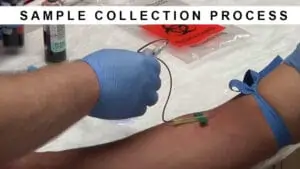Sample collection
The process of acquiring tissues, fluids, any other sample, or material for laboratory analysis is called the sample collection process.
For example, if we want to analyze the protein source, it will be eggs because eggs contain a high amount of protein, which will be our sample of analysis.
 This involves many things that we can keep in mind during the sample collecting process, such as:
This involves many things that we can keep in mind during the sample collecting process, such as:
- The adequacy and conditions (temperature, moisture, etc) for the sample or specimen received for analysis are of great importance.
- Adequate amounts of samples are collected so that if we malfunction the test then we can use extra sample
- Minimize time for calculations.
- Clean and packed apparatus is used.
- An experienced person should be selected to collect the sample.
- If the samples are improperly collected, then the laboratory results are meaningless.
Sample collecting steps are given below:
Preparation of sample collection process
Ensure you have the proper tools for sample collection such as sterile containers, swabs, injections, etc.
Identification of sample
Determine what type of sample you need to collect based on the purpose of the analysis.
- Follow the specific collection technique for the type of sample you have collected.
- These may involve syringes, swabs, or pipettes depending on the type of sample.
Quantity
Collect the appropriate amount of samples as per the testing requirements.
Storage
Properly label and store the collected sample in the appropriate containers. The container should be sterile and should give the proper temperature that the sample requires for its proper function.
Transportation
If needed, transportation of the sample to the testing facility using proper precautions, to maintain the integrity of the sample.
Sample handling
It refers to the various processes and procedures involved in the proper management of the sample.
- labeling
- preparations for analysis
- auto-clave centrifuge tubes
- blood should be screened
It prevents contamination. Proper conditions such as temp, humidity, etc should be labeled. It will help out while handling and processing. The sample should be dried.
Sample preparation
Define: The process in which a representative piece of material is extracted from a large amount of sample is called sample preparation.
Drying the sample
The sample must be dried and ensured that it will be moisture-free. Low temperature is available for drying the volatile samples at 35 °C or 45 °C. Techniques used for the drying process are given below:
- Spray drying
- evaporation
- crushing or grinding
Spray drying
Spray drying involves atomizing a liquid sample into a hot gas stream that evaporates the solvent present in the sample and collects the dry particles. This drying process occurs with the help of nitrogen gas or air, by lyophilization process (removal of liquid and water from the sample to purify the product by using a sublimation technique), and vacuum, or ultrasonic spray drying. It will be helpful in food analysis, environmental monitoring biochemical research, and forensic science.
Evaporation
Evaporation process involves removal of water from liquid sample leaving behind the analyte of interest behind.
Rotary, vacuum heat centrifugal freeze-drying, and nitrogen blown-down evaporations are used in sample preparation. This process is used in the preparation of samples for chromatography, purification of biological samples, food and beverage analysis, removal of volatile solvents, and concentration of the dilute solutions.
Crushing and Grinding
The crushing and grinding process is performed because it reduces particle size, increases surface area, homogenizes the sample, and improves analytical accuracy. Some factors that may depend on crushing efficiency are:
- sample hardness
- moisture content
- contamination risk
- particle size distribution
- energy input
10mm size is suitable for standard crushing 02mm for fine crushing and less than 2mm or extra fine crushing. A pulverizer is a mechanical device used for the grinding of different types of materials. This process can enhanced extraction efficiency and analytical accuracy.
This process is used for urine, blood, drug tests for the detections of specific samples.


